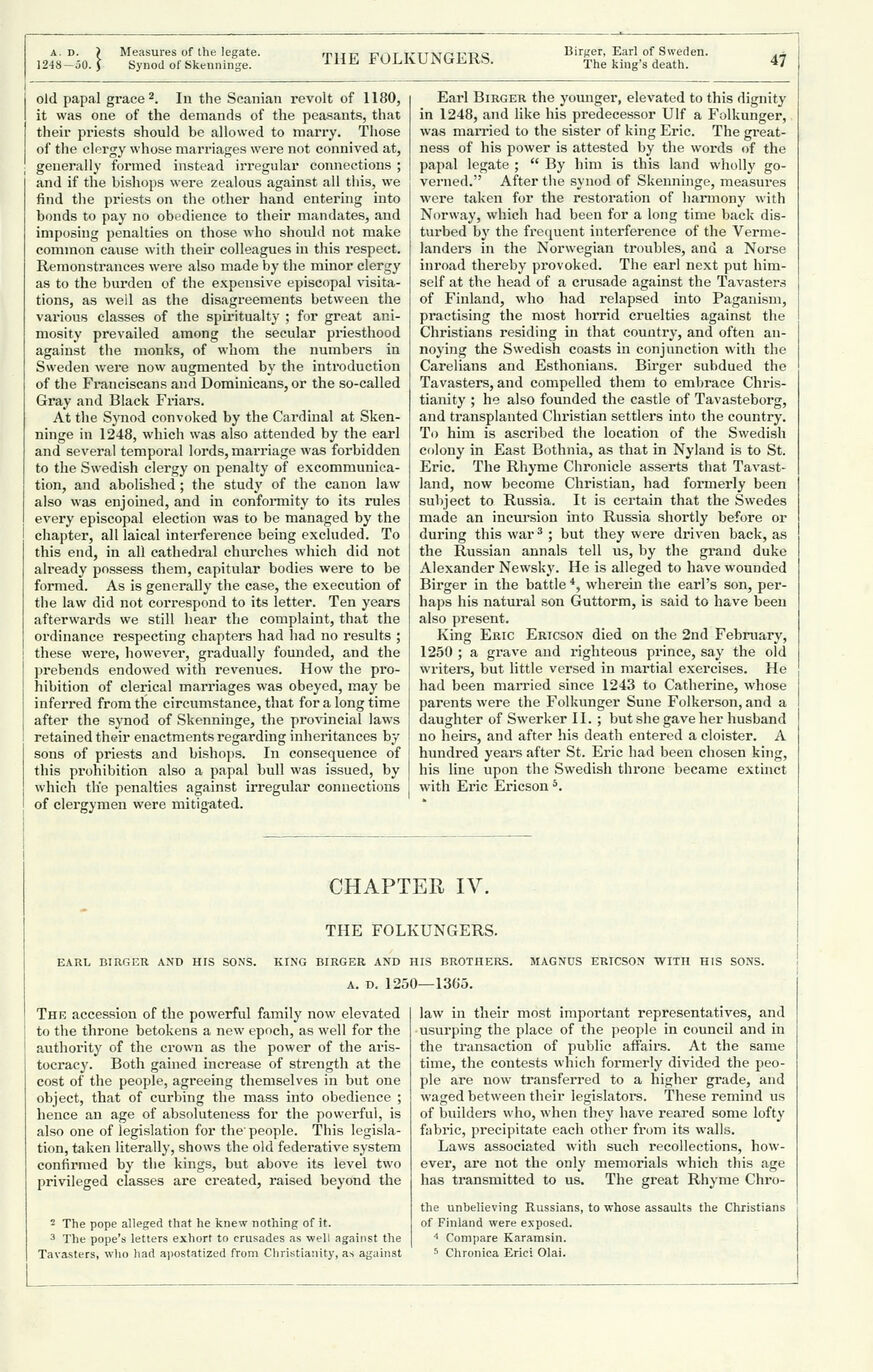
Full resolution (JPEG) - On this page / på denna sida - III. Establishment of Christianity. Contests of the Swedes and Goths for Supremacy. A.D. 800—1250 - IV. The Folkungers. A.D. 1250—1365

<< prev. page << föreg. sida << >> nästa sida >> next page >>
Below is the raw OCR text
from the above scanned image.
Do you see an error? Proofread the page now!
Här nedan syns maskintolkade texten från faksimilbilden ovan.
Ser du något fel? Korrekturläs sidan nu!
This page has been proofread at least once.
(diff)
(history)
Denna sida har korrekturlästs minst en gång.
(skillnad)
(historik)
old papal grace [1]. In the Scanian revolt of 1180,
it was one of the demands of the peasants, that
their priests should be allowed to marry. Those
of the clergy whose marriages were not connived at,
generally formed instead irregular connections;
and if the bishops were zealous against all this, we
find the priests on the other hand entering into
bonds to pay no obedience to their mandates, and
imposing penalties on those who should not make
common cause with their colleagues in this respect.
Remonstrances were also made by the minor clergy
as to the burden of the expensive episcopal visitations,
as well as the disagreements between the
various classes of the spiritualty; for great
animosity prevailed among the secular priesthood
against the monks, of whom the numbers in
Sweden were now augmented by the introduction
of the Franciscans and Dominicans, or the so-called
Gray and Black Friars.
At the Synod convoked by the Cardinal at Skenninge
in 1248, which was also attended by the earl
and several temporal lords, marriage was forbidden
to the Swedish clergy on penalty of excommunication,
and abolished; the study of the canon law
also was enjoined, and in conformity to its rules
every episcopal election was to be managed by the
chapter, all laical interference being excluded. To
this end, in all cathedral churches which did not
already possess them, capitular bodies were to be
formed. As is generally the case, the execution of
the law did not correspond to its letter. Ten years
afterwards we still hear the complaint, that the
ordinance respecting chapters had had no results;
these were, however, gradually founded, and the
prebends endowed with revenues. How the prohibition
of clerical marriages was obeyed, may be
inferred from the circumstance, that for a long time
after the synod of Skenninge, the provincial laws
retained their enactments regarding inheritances by
sons of priests and bishops. In consequence of
this prohibition also a papal bull was issued, by
which the penalties against irregular connections
of clergymen were mitigated.
Earl Birger the younger, elevated to this dignity
in 1248, and like his predecessor Ulf a Folkunger,
was married to the sister of king Eric. The
greatness of his power is attested by the words of the
papal legate; “By him is this land wholly
governed.” After the synod of Skenninge, measures
were taken for the restoration of harmony with
Norway, which had been for a long time back
disturbed by the frequent interference of the
Vermelanders in the Norwegian troubles, and a Norse
inroad thereby provoked. The earl next put himself
at the head of a crusade against the Tavasters
of Finland, who had relapsed into Paganism,
practising the most horrid cruelties against the
Christians residing in that country, and often
annoying the Swedish coasts in conjunction with the
Carelians and Esthonians. Birger subdued the
Tavasters, and compelled them to embrace Christianity;
he also founded the castle of Tavasteborg,
and transplanted Christian settlers into the country.
To him is ascribed the location of the Swedish
colony in East Bothnia, as that in Nyland is to St.
Eric. The Rhyme Chronicle asserts that Tavastland,
now become Christian, had formerly been
subject to Russia. It is certain that the Swedes
made an incursion into Russia shortly before or
during this war [2]; but they were driven back, as
the Russian annals tell us, by the grand duke
Alexander Newsky. He is alleged to have wounded
Birger in the battle [3], wherein the earl’s son,
perhaps his natural son Guttorm, is said to have been
also present.
King Eric Ericson died on the 2nd February,
1250; a grave and righteous prince, say the old
writers, but little versed in martial exercises. He
had been married since 1243 to Catherine, whose
parents were the Folkunger Sune Folkerson, and a
daughter of Swerker II.; but she gave her husband
no heirs, and after his death entered a cloister. A
hundred years after St. Eric had been chosen king,
his line upon the Swedish throne became extinct
with Eric Ericson [4].
<< prev. page << föreg. sida << >> nästa sida >> next page >>